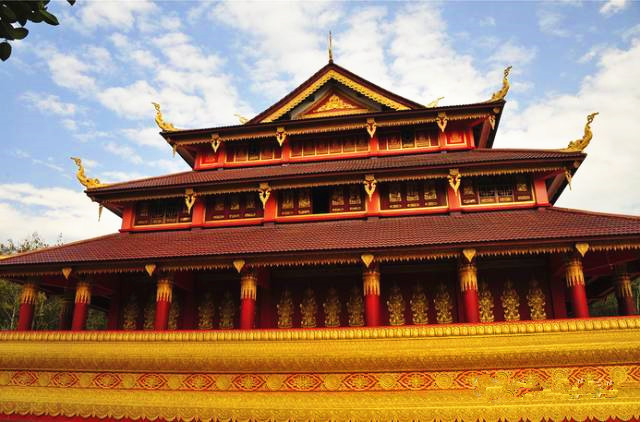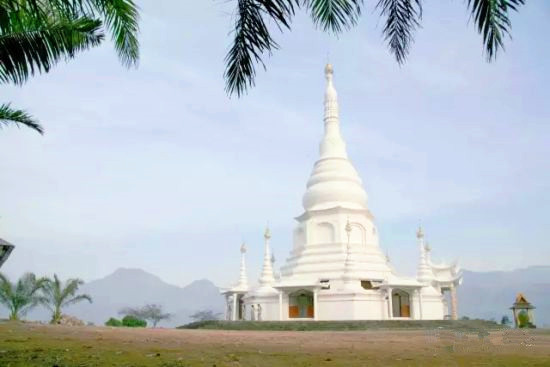
Dongjing Temple in Gengma County, Lincang
Overview
Dongjing Temple耿马县孟定洞景佛寺, located in Dongjing Village (洞景寨), Gengma County (耿马傣族佤族自治县), Lincang (临沧), Yunnan Province (云南省), was established in the 874th year of the Dai calendar (1512 AD). This temple, covering an area of 106 acres, is recognized as a city-level cultural heritage site.
The architectural structure and decor of Dongjing Temple reflect the Southern Theravada Buddhist forest school. Inside the Main Hall, there is a large golden statue of Shakyamuni Buddha (释迦牟尼) and 22 statues of Maitreya Buddha (弥勒) in a reclining position, each with distinct expressions. The temple is renowned in Southeast Asia for housing the sacred relic of Shakyamuni Buddha, known as “Shari” (舍利子).
Temple Features
Dongjing Temple is situated in a mountainous forest area next to Dongjing Village, approximately 9 kilometers from Mengding Town (孟定镇). It belongs to the forest-style temples of the Southern Theravada Buddhist school, specifically the Payun sect (摆润教派). The term “Dongjing” in the Dai language refers to the sacred relic of the Buddha’s collarbone.
According to Buddhist scriptures such as the “Da Ta” (赕大塔) and “Buna Wa” (布纳洼), the origins of Dongjing Temple are summarized by the lay practitioner Ying Dajia (英达嘎居士). This location was where the Buddha, in one of his 550 reincarnations as a monkey, got lost while foraging with his mother, leading to his eventual demise. This place became known as the “Forgotten Mother” site.
In the year 248 of the Buddhist calendar (398 BC), during the time of Tanma Xini Suoga (坦麻细尼索嘎), monks from Lanka (the Indian name for Sri Lanka) brought the relic of Shakyamuni’s collarbone and buried it here in a copper box, constructing a stupa above it. Thus, this site is known as Dongjing, meaning the location of the Buddha’s collarbone relic.
In the mid-Qing Dynasty, the local chieftain of Gengma (耿马土司) restored the temple and stupa. However, it was damaged during the Cultural Revolution. After the policy of religious freedom was reinstated, restoration efforts began in 1989. During the reconstruction of the stupa on April 20, 1994, many treasures, including 69 bronze statues and inscriptions, were unearthed, along with a 3-centimeter-long dark red crystal, believed to be part of the Buddha’s collarbone relic.
Currently, the Dongjing Stupa (洞景佛塔) stands 35.27 meters tall and has a diameter of 40.5 meters, covering an area of 907 square meters. It consists of a main stupa, eight smaller stupas, and eight Buddha pavilions. Each of the smaller stupas houses a Buddha statue, surrounding the main Buddha like stars around the moon. The architectural style and decor of the temple also belong to the Southern Theravada Buddhist forest school, with no resident monks. The Main Hall contains a large golden statue of Shakyamuni Buddha and 22 statues of reclining Maitreya Buddha, making it a sacred site for Buddhist pilgrims from within and outside the region.
Cultural Significance of the Relic
According to the temple’s history, after Shakyamuni’s passing, his body was cremated, resulting in the “Shari” crystal bones, which were divided into eight parts and spread across different regions to benefit all sentient beings. One part of Shakyamuni’s relic found its way to Mengding and was buried within Dongjing Temple. In 1994, during the stupa’s restoration, 69 statues, jewelry, and other artifacts were discovered, including two copper inscriptions confirming the temple’s possession of the sacred relic. The discovery of a 3-centimeter-long oval crystal bone, believed to be the collarbone relic of Shakyamuni, added to the temple’s mystique, making it a significant Buddhist pilgrimage site throughout Southeast Asia.
Travel Information
How to Get There
By Car
From Mengding Town, drive approximately 9 kilometers to Dongjing Village. The journey takes about 20 minutes by car.
By Public Transportation
Buses from Mengding Town to Dongjing Village operate regularly. The journey takes around 30 minutes, with tickets priced at approximately ¥10 per person. After arriving, follow the signs to reach Dongjing Temple.
Travel Tips
- Best Time to Visit: Early morning or late afternoon for cooler weather and fewer crowds.
- Respect Local Customs: Follow the temple’s etiquette and dress modestly.
- Photography: Always ask for permission before taking photos, especially of rituals or ceremonies.
- Local Cuisine: Explore local Dai cuisine at nearby eateries to enrich your travel experience.
- Guided Tours: Consider hiring a local guide for deeper insights into the temple’s history and cultural significance.
- Stay Hydrated: Bring water, especially during warmer months, as the temple grounds can be expansive.



 7 Days GolfingTour
7 Days GolfingTour
 8 Days Group Tour
8 Days Group Tour
 8 Days Yunnan Tour
8 Days Yunnan Tour
 7 Days Shangri La Hiking
7 Days Shangri La Hiking
 11 Days Yunnan Tour
11 Days Yunnan Tour
 6 Days Yuanyang Terraces
6 Days Yuanyang Terraces
 11 Days Yunnan Tour
11 Days Yunnan Tour
 8 Days South Yunnan
8 Days South Yunnan
 7 Days Tea Tour
7 Days Tea Tour
 8 Days Muslim Tour
8 Days Muslim Tour
 12 Days Self-Driving
12 Days Self-Driving
 4 Days Haba Climbing
4 Days Haba Climbing
 Tiger Leaping Gorge
Tiger Leaping Gorge
 Stone Forest
Stone Forest
 Yunnan-Tibet
Yunnan-Tibet
 Hani Rice Terraces
Hani Rice Terraces
 Kunming
Kunming
 Lijiang
Lijiang
 Shangri-la
Shangri-la
 Dali
Dali
 XishuangBanna
XishuangBanna
 Honghe
Honghe
 Kunming
Kunming
 Lijiang
Lijiang
 Shangri-la
Shangri-la
 Yuanyang Rice Terraces
Yuanyang Rice Terraces
 Nujiang
Nujiang
 XishuangBanna
XishuangBanna
 Spring City Golf
Spring City Golf
 Snow Mountain Golf
Snow Mountain Golf
 Stone Mountain Golf
Stone Mountain Golf


















